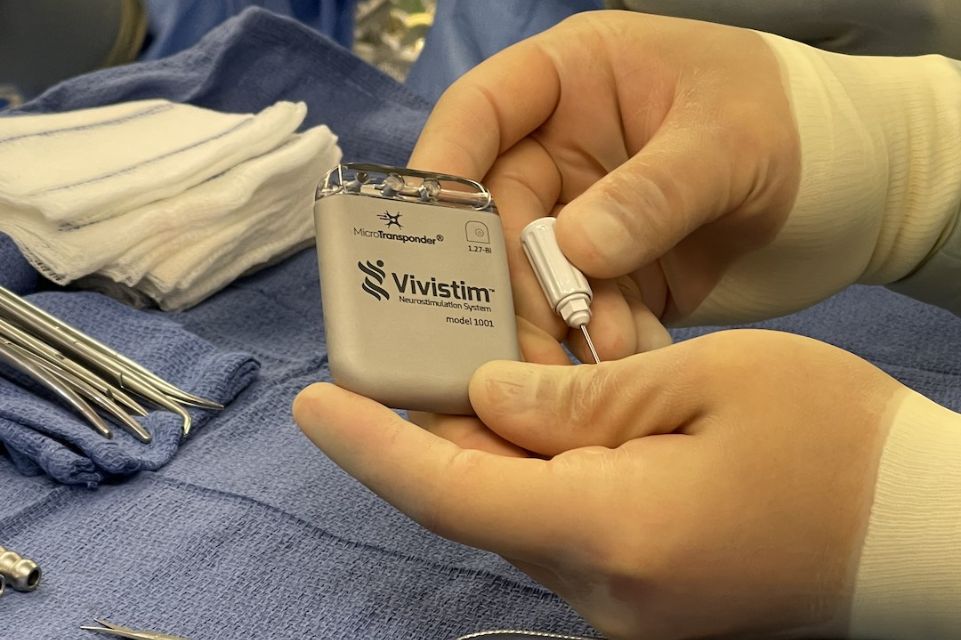Tampa General Conducts First Procedure on the West Coast of Florida With Device Designed to Revive Arm Function After Stroke
Published: Mar 19, 2024
Once implanted under the skin and paired with physical therapy, Vivistim gives patients a better chance of returning to their daily activities.
Tampa, FL (March 19, 2024) – Tampa General Hospital (TGH) is the first hospital on the West Coast of Florida to provide new hope to stroke patients experiencing loss of upper limb function with the help of a pacemaker-like device implanted under the skin.
“Combined with a six-week physical therapy protocol, the device significantly improves upper limb function for stroke patients,” said Dr. Oliver Flouty, assistant professor in the Department of Neurosurgery and Brain Repair at the USF Health Morsani College of Medicine and a neurosurgeon at Tampa General. He performed the academic health system’s first implant Nov. 7, 2023.
With the dual therapy, patients can return to the activities and tasks they used to perform, such as buttoning a shirt, preparing a meal or even playing a guitar. “This device shows great promise as a key component in helping to improve the quality of life for our patients,’’ Flouty said. “It’s an exciting new breakthrough.’’
Called Vivistim, the device provides Paired Vagus Nerve Stimulation, or Paired VNS. It was designed to strengthen the brain connections needed to improve hand and arm function. It does this by increasing neuroplasticity and enhancing repetitive-motion therapy, and, because the patient wears the device, it’s portable.
“We have high expectations that the Vivistim system will revive hope for stroke survivors by addressing an unmet need for those who have chronic impairment,” said Dr. Harry van Loveren, professor and chair of the Department of Neurosurgery and Brain Repair and vice dean for Clinical Affairs for the USF Health Morsani College of Medicine and chief of the TGH Neuroscience Institute for Neurosurgery. “Stroke survivors whose hand and arm function haven’t improved can now work with specialists at Tampa General to assess their needs and be treated.’’
During rehabilitation exercises and at-home activities, the device gently stimulates the brain via the vagus nerve, which carries signals from the brain to other parts of the body. (“Vagus” is the Latin word for wandering, named because the nerve takes a long, winding course through the body.)
During a patient’s rehabilitation, a therapist signals the device to deliver a gentle pulse to the vagus nerve while the stroke survivor performs a specific or functional task. This pairing of the rehabilitation exercise with VNS strengthens neural connections in areas of the brain outside the damaged region, improving upper-limb function and increasing the effectiveness of the therapy. The device is painless; what users feel is a noticeable improvement in hand and arm function over time, allowing them to return to many of their daily activities. Additionally, it can be used in a home setting once the rehabilitation protocol has been completed.
The Vivistim system received Food and Drug Administration (FDA) approval following a decade of preclinical research and a randomized controlled clinical trial that was peer-reviewed and published in The Lancet. https://www.thelancet.com/journals/lancet/article/PIIS0140-6736(21)00475-X/fulltext
Stroke survivors who have benefited from Vivistim reported enhancement across numerous quality-of-life measures, including mobility and self-care, according to the report.
“This system, along with the physical therapy regimen, can open new doors for stroke survivors living with the limitations of reduced hand and arm function, which has the potential to greatly improve their quality of life,” said Tom Cairo, senior administrator, Neurosciences, Orthopaedics and Behavioral Health, Tampa General.
